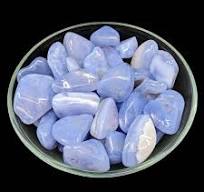
Blue Chalcedony: The Soothing Sky Stone
Blue Chalcedony is a serene and luminous member of the quartz family, prized for its gentle blue hues and tranquil energy. Embraced by lovers of raw crystal jewellery, mineral specimen necklaces, and handmade gemstone rings, this stone is celebrated for its calming presence and soothing aesthetic.
Geological Information: Composition, Structure & Origins
-
Composition: A microcrystalline form of quartz (SiO₂), Blue Chalcedony is made up of densely packed microscopic crystals, giving the stone its distinctive soft sheen, known as an “adamantine” or “greasy” lustre.
-
Structure: With a cryptocrystalline structure, Blue Chalcedony ranges from translucent to almost opaque. Its even, waxy texture is ideal for carving, cutting, and polishing.
-
Hardness: Typically 6.5–7 on the Mohs scale, it is durable enough for everyday wear in crystal specimen rings or pendants.
-
Colour: Ranges from pale cornflower blue to deeper cornflower or robin’s‑egg, often with slight grey undertones. Even colouring without inclusions is highly prized.
-
Origins: Sourced from Madagascar, Namibia, Turkey, and the USA (notably California). Variations occur due to trace mineral inclusions and environmental formation conditions.
Its soothing blue palette captures the essence of sky and water, making it a calming choice for raw crystal jewellery.

Energetic Meaning & Healing Properties
Blue Chalcedony shines as a stone of calm, communication, and alignment:
-
Soothing and Balancing – Frequently used for anxiety relief and emotional stabilisation, its gentle vibration mimics a peaceful sky, helping to steady frazzled nerves.
-
Enhancing Communication – Connected to the throat chakra, this stone encourages honest, heartfelt dialogue and aids articulate expression.
-
Psychic Harmony – Some spiritual practitioners use Blue Chalcedony for telepathy, dream recall, and intuitive alignment without energetic overwhelm.
-
Creative Inspiration – Known to stimulate self-expression, especially in artistically or emotionally creative work.
Energy workers treasure Blue Chalcedony for meditation and soothing discomforts related to throat or vocal strain.
Collectible Appeal & Natural Beauty
Blue Chalcedony is beloved by collectors for its uniform colour and satin finish:
-
Raw Nodules & Drusy Specimens – Offer a tactile, earth-born charm ideal for mineral specimen necklaces.
-
Polished Cabochons – Smooth, oval shapes bring out its silken glow in handmade gemstone rings and minimal bezel settings.
-
Tumbled Pieces – Perfect for worry stones or discreet carrying, preserving the stone's gentle texture.
True specimens often display natural banding or residual drusy surfaces—each piece entirely unique, ideal for lovers of understated elegance.
Blue Chalcedony in Cultural Lore and Mysticism
Though not as widely mythologised as other gemstones, Blue Chalcedony holds a steady place in the folklore of several ancient cultures:
-
Ancient Romans believed Chalcedony would protect against evil spirits and encourage inner peace.
-
Tibetan monks used Blue Chalcedony beads in malas, attributing calming and centring energies to the stone.
-
In Native American traditions, the stone was associated with weather magic, likely due to its cloud-like appearance and connection to water.
These threads of tradition continue in contemporary crystal healing, where the stone’s "sky and water" essence symbolises emotional release and mental clarity.
Comparison with Similar Crystals
Blue Chalcedony is sometimes confused with other gentle blue stones—but it holds its own in uniqueness:
-
Versus Aquamarine: Aquamarine, a beryl, has a glassier, more translucent quality and stronger links to courage and the sea. Chalcedony is subtler, more waxy, and emotionally gentler.
-
Versus Angelite: While Angelite shares similar calming effects, it is far softer (Mohs 3.5) and more opaque, making Blue Chalcedony better suited for wearable jewellery.
-
Versus Blue Lace Agate: Blue Chalcedony is typically more uniform in colour, whereas Blue Lace Agate displays delicate banding and layering.
Its softness, visual serenity, and structure place it at the intersection of beauty and gentle strength.
Jewellery Use and the Raw Form Aesthetic
Blue Chalcedony is versatile in design, lending itself beautifully to both polished and raw jewellery formats:
-
Raw Crystal Jewellery: When used in its natural nodule or slab form, Blue Chalcedony evokes an ethereal aesthetic—perfect for minimalist, grounding designs.
-
Mineral Specimen Necklace: The stone's sculptural potential is often highlighted in wire-wrapped or claw-set pieces, preserving its raw geometry.
-
Crystal Specimen Rings: When faceted subtly, Blue Chalcedony retains its cloudy translucence, adding an air of softness to statement rings.
-
Handmade Gemstone Rings: Delicate bezels and naturalistic finishes complement this stone’s nurturing energy, often crafted to sit low on the hand for comfort and everyday wear.
In all its forms, Blue Chalcedony whispers rather than shouts—an understated statement of healing and harmony.

A Gentle Mention of Oryssia
In the hands of artisans who appreciate raw beauty, Blue Chalcedony becomes more than adornment—it becomes an amulet. Our studio is home to creations that honour its form without over-polishing its story, letting each piece speak through its own silent frequency.